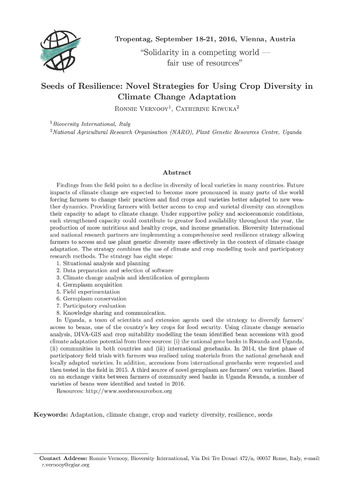Seeds of resilience: novel strategies for using crop diversity in climate change adaptation
Findings from the field point to a decline in diversity of local varieties in many countries. Future
impacts of climate change are expected to become more pronounced in many parts of the world
forcing farmers to change their practices and find crops and varieties better adapted to new wea-
ther dynamics. Providing farmers with better access to crop and varietal diversity can strengthen
their capacity to adapt to climate change. Under supportive policy and socioeconomic conditions,
such strengthened capacity could contribute to greater food availability throughout the year, the
production of more nutritious and healthy crops, and income generation. Bioversity International
and national research partners are implementing a comprehensive seed resilience strategy allowing
farmers to access and use plant genetic diversity more effectively in the context of climate change
adaptation. The strategy combines the use of climate and crop modelling tools and participatory
research methods. The strategy has eight steps:
1. Situational analysis and planning
2. Data preparation and selection of software
3. Climate change analysis and identification of germplasm
4. Germplasm acquisition
5. Field experimentation
6. Germplasm conservation
7. Participatory evaluation
8. Knowledge sharing and communication.
In Uganda, a team of scientists and extension agents used the strategy to diversify farmers’
access to beans, one of the country’s key crops for food security. Using climate change scenario
analysis, DIVA-GIS and crop suitability modelling the team identified bean accessions with good
climate adaptation potential from three sources: (i) the national gene banks in Rwanda and Uganda,
(ii) communities in both countries and (iii) international genebanks. In 2014, the first phase of
participatory field trials with farmers was realised using materials from the national genebank and
locally adapted varieties. In addition, accessions from international genebanks were requested and
then tested in the field in 2015. A third source of novel germplasm are farmers’ own varieties. Based
on an exchange visits between farmers of community seed banks in Uganda Rwanda, a number of
varieties of beans were identified and tested in 2016.
Resources: http://www.seedsresourcebox.org

